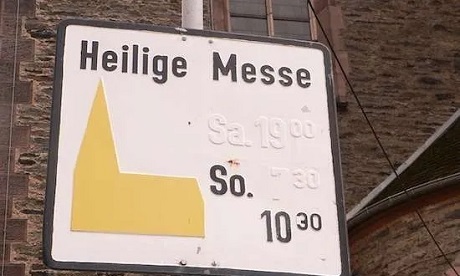It is proverbial wisdom that ‘One picture is worth a thousand words.’
That is certainly true of the picture above – it is worth many thousands of words as we approach the synod in October.
Dare I say it, it is worth a thousand of the numbered statements in Denzinger!
Please study the picture closely.
It is typical of the signs one sees on the outskirts of villages and towns in Germany. The image of a building in yellow tells the viewer that the only church/chapel in the town is Catholic.
The letters and numbers tell the days and times when Catholics there gather to celebrate the Eucharist. ‘Sa’ is an abbreviation for Saturday, and ‘So’ for Sunday; the numbers are self-explanatory.
Now look more closely!
There used to be – in the time since the sign was put up – three celebrations: one on Saturday evening, and two on Sunday morning.
Now part of the sign has been painted over: there is now only one eucharistic assembly!
Why is this?
It could be that the population has dropped by 66 percent. But that cannot explain it since there is a big new housing estate nearby: the town is growing in population.
It could be that there are fewer people ‘going to church.’
That is almost certainly the case. Rejection of the church has been increasing in recent years with more and more people formally renouncing their membership of the Catholic Church; and there has been a decrease in religious practice across the churches generally.
But would that explain why there is now only one Mass over a weekend instead of three? Of course not!
The real problem
The reason is not hard to find: it is due to there being not enough presbyters to preside over the assemblies – what is incorrectly referred to as either ‘the priest shortage’ or ‘the vocations’ crisis.’
It is the same story across diocese after diocese and country after country.
Fewer presbyters, older presbyters, and empty seminaries mean that the few men there are available being spread thinner and thinner. That is why the white paint has been applied to this sign to alter it.
We can engage in platitudes. I see one diocese claims that it is not ‘closing parishes’ but ‘restructuring.’ Such statements belong to the deceitful world of spin doctors rather than to those who claim to be successors of the apostles.
Many other dioceses try to avoid facing the issue by importing young presbyters from the developing world.
Are they not needed there?
Is there no need for them to help their own communities? Is this not a form of neo-colonialism – stripping the developing world of its assets for the sake of the rich countries?
Should not a presbyter emerge from out of the community: a basic sign of an inculturated liturgy?
Older and more tired
What has happened in this town is that where there used to be three presbyters in three towns, now there is one man travelling between them. You probably know a place near you where this is happening.
But the presbyters are old and often tired.
The assemblies are often too big – one cannot genuinely relate to a community of hundreds!
To imagine one can just ‘scale up’ the size of a congregation from one hundred to two hundred – or even more – without detriment to the level of participation in the liturgy is a failure to understand both how humans relate and the nature of a eucharistic celebration.
It is a gathering of family (we call each other ‘brothers and sisters’) and friends (‘I call you friends’ – Jesus) not a ‘service provision event.’
Moreover, the presbyter has to pretend that each celebration is the centre and summit of his day – yet his demeanour may reveal his exhaustion.
Please do remember that is it less than a 100 years ago since celebrating two Masses on one day (except in an emergency) needed a special permission from the bishop – ‘bination’ was seen as most exceptional.
Most of the Orthodox churches still do not permit it.
Face the problem
Meet any group of presbyters and they will openly talk about the problem. Often as soon as a bishop enters the room, the discussion falls silent!
But if this problem is not addressed openly at the synod, then much of what it will discuss will have an air of unreality.
That sign is truly a sign for the times.
- Thomas O’Loughlin is a presbyter of the Catholic Diocese of Arundel and Brighton and professor-emeritus of historical theology at the University of Nottingham (UK).
- First published in La Croix. Republished with permission.
- His latest book is “Shaping the Assembly: How Our Buildings form us in Worship”.
News category: Analysis and Comment, Great reads.




